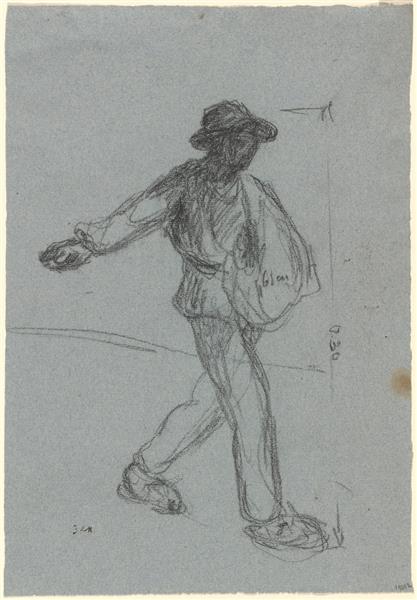Beskrivelse
Arbeidet "The Sowing" av Jean-François Millet, malt i 1850, er et kraftig vitnesbyrd om landsbygda og verdigheten til landbruksarbeid. I dette maleriet fanger Mill ikke bare den fysiske handlingen, men også den åndelige og symbolske forbindelsen mellom menneske og jord. Den sentrale karakteren, en bonde i en dynamisk stilling, er representert i det nøyaktige øyeblikket av å lansere frøene til bakken, en gest som legemliggjør håpet og livssyklusen. Gjennom behandlingen av figuren klarer Millet å formidle en følelse av innsats og engasjement, samt en dyp respekt for landsarbeidet.
Sammensetningen av verket er bemerkelsesverdig for dets eleganse og dets evne til å rette betrakterens blikk. Den såingsfiguren er plassert i forgrunnen, litt til venstre for scenen, som skaper en diagonal som strekker seg til bunnen, der omfattende felt og en svak himmel er glumet. Orienteringen av figuren, med ryggen til betrakteren, foreslår en invitasjon til å bli med i arbeidet og meditere om betydningen av arbeidet. Dette, sammen med tilbøyeligheten til den såingslegemet, forsterker ideen om bevegelse og nesten rituelt arbeid.
Fargene som brukes av hirse i "The Sowing" er overveiende forferdelig, med toner av brunt, grønt og gult som fremkaller den fruktbare jorden. Fargepaletten er med vilje edru, med fokus på naturen og essensen i landlige miljø. Kontrasten mellom såing, kledd i enkle klær, og landskapet fremhever figuren og dens handling, mens den knapt nyanserte himmelen antyder daggry eller solnedgang, og dermed kobler landbruksarbeidet med den naturlige syklusen.
"The Sowing" er et representativt verk av den realistiske bevegelsen, som forsøkte å skildre hverdagen til arbeiderklasser i motsetning til romantikkens idealiseringer. Millet blir en sentral figur i denne bevegelsen gjennom sitt fokus på oppriktighet og ekthet av landbruksarbeid. Hans portretter av landlige bønder og scener har påvirket mange senere kunstnere og har åpnet veien for en større forståelse av arbeidskunst.
I tillegg til å være en intim og rørende representasjon av landbruket, gjenspeiler arbeidet de sosiale forholdene i tiden. I løpet av det nittende århundre transformerte den industrielle revolusjonen raskt liv til Europa, og bildene av landsbygdslivet ble et symbol på dehumaniseringsresistens som fulgte med industrialisering. Miret, gjennom sin kunst, hedret bøndenes verk og løftet dem til staten hverdagshelter.
Den såingsfiguren har holdt ut i visuell kultur, og blitt et emblem for menneskets tilknytning til natur og arbeid. Denne representasjonen, selv om den er enkel i sin sammensetning og henrettelse, er gjennomsyret av en dyp filosofi om menneskelig arbeid og dens plass i verden. Maleriet inviterer betrakteren til å reflektere over forholdet mellom menneske og jord, en dialog som er like relevant i dag som det var i Millets tid.
"The Sowing" er ikke bare et bilde av landbruksarbeid; Det er en meditasjon om offer, kontinuitet og håp om at såing av såing legemliggjør. Arbeidet gjenstår derfor som et fyrtårn som illustrerer verdien av arbeidet i konstruksjonen av samfunnet og forevigelsen av livet. I Millets evne til å fange essensen av mennesket i det naturlige landskapet, finner vi ikke bare en virkelighetsoppslag, men en oppfordring til å gjenkjenne skjønnheten og verdigheten som stammer fra den daglige kampen for å dyrke og bebor vår verden.
KUADROS ©, en berømt maling på veggen din.
Håndlagde oljemalerier, med kvaliteten på profesjonelle kunstnere og den særegne forseglingen til KUADROS ©.
Bilder reproduksjonstjeneste med tilfredshetsgaranti. Hvis du ikke er helt fornøyd med kopien av maleriet ditt, refunderer vi pengene dine 100%.

